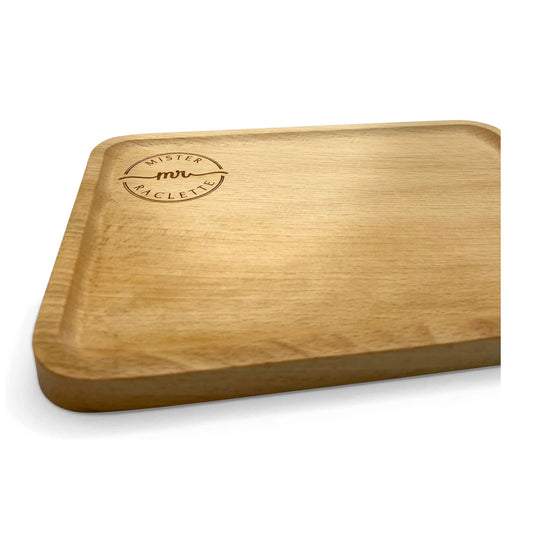Quels sont les fromages à raclette ?
Raclette is a convivial dish par excellence, deeply rooted in Swiss tradition. But did you know that there are a variety of cheeses specially adapted for a perfect raclette? In this article, we'll take you on a journey of discovery through the different types of raclette cheese, with a particular focus on those from Switzerland. Get ready to discover their unique characteristics, inimitable taste and the best ways to enjoy them.
Origin of Valais raclette cheese
The word “raclette” comes from the French verb “racler”, meaning to scrape. The dish originated in the Swiss canton of Valais, where shepherds would melt cheese by a wood fire before scraping it onto potatoes. Valais AOP (Appellation d'Origine Protégée) raclette cheese is still the most authentic and respected of all raclette cheeses. Its pressed, uncooked paste is made from raw cow's milk, giving it an intense, rich, slightly spicy taste.
Over the centuries, raclette has crossed borders and gained in popularity not only throughout Switzerland, but also in the Savoie region of France, where the famous “raclette de Savoie” is now found. This cheese, although not very similar to its Swiss cousin, has its own nuances of flavor.
Characteristics of Swiss raclette cheeses
Switzerland is renowned for the quality of its cheeses, and raclette cheeses are no exception. Swiss raclette cheese is distinguished by its melt-in-the-mouth texture and mild yet complex taste. A wheel of semi-hard cheese is made mainly from cow's milk, although goat's milk variants also exist, for those seeking a more pronounced flavor.
Swiss raclette cheeses are often matured for between three and six months. This allows the cheese to develop a distinct character while retaining a certain sweetness, ideal for pleasing all guests at a successful raclette. The same applies to Valais alpine cheese.
Swiss raclette cheese varieties
Swiss raclette cheese varieties include :
1. Raclette du Valais AOP:The most emblematic of all, with its incredible taste and aroma. Made exclusively in the canton of Valais, these products are a must for every raclette enthusiast.
2. Raclette de Bagnes: Another Valais gem, often considered one of the best variants of Swiss raclette cheese. Its supple paste melts perfectly, offering a rich, creamy taste.
3. Fromage à Raclette du Jura Suisse: This cheese has a milder, creamier flavor, making it very popular with families. Its melt-in-the-mouth texture is ideal for raclette with friends and family.
4. Raclette de Zermatt: Originating from the Zermatt region, this cheese has a more intense, slightly spicy touch, perfect for lovers of bolder flavors.
Artisanal vs. industrial cheeses
When it comes to raclette, cheese quality can vary greatly depending on how it is produced. Artisanal cheeses, such as Raclette du Valais AOP, are often made in small batches from raw cow's milk, giving them an incomparable richness and depth of flavor. These cheeses are usually carefully matured, sometimes in cellars, allowing them to develop complex flavors.
Industrial cheeses, although more affordable in terms of price, may have a less pronounced taste. They are often pasteurized, which reduces some of the flavor nuances of raw milk. However, they remain a valid option for large-scale raclettes where budget and practicality are priorities.
Traditional raclette accompaniments and potatoes
There's more to a Swiss raclette than cheese. The accompaniments play a crucial role in the culinary experience. Here are a few suggestions for enhancing your raclette:
- Potatoes: Traditionally, firm-fleshed potatoes are preferred for their texture, which contrasts with the melting sweetness of the cheese.
- Pickled gherkins and onions: These condiments add a touch of acidity, perfect for balancing the richness of the cheese.
- Charcuterie: Cured ham, dried meat from the Valais (Grison) and dry-cured bacon from the Valais blend perfectly with the melted cheese.
- Pepper and spices: A little freshly ground pepper can enhance the taste of cheese and add a personal touch to any dish.

The role of the heat source in a successful raclette
Historically, raclette cheese was melted over a wood fire, giving the cheese a slightly smoky flavor. Today, modern raclette appliances use electricity to heat the cheese directly under a resistor. Although this method is more convenient, purists agree that nothing beats a raclette melted over a flame. Which is still the best recipe for milk cheese.
For those seeking to recreate this tradition, there are appliances that mimic the heat of a fire, allowing you to melt cheese directly on a wheel and scrape it the old-fashioned way.
Why choose Swiss cheeses for your raclette?
In addition to their unique taste, Swiss raclette cheeses offer unrivalled quality. Their manufacture is based on centuries of cheese-making tradition, and each Swiss canton has its own specialities. Whether you opt for a Valais PDO raclette, a Bagnes raclette or a Zermatt raclette, you can be sure of enjoying an authentic mountain cheese.
Things not to do with Swiss cheese raclette
There are a few things to avoid when making a successful raclette with Swiss cheese. First of all, don't replace raclette cheese with other unsuitable cheeses, such as Camembert de Normandie or a rondin de brebis, as they don't melt well and alter the texture. If you want to experiment, local cheeses or a slight addition of goat's cheese may be suitable, but don't distort the traditional recipe. Finally, don't leave the cheese too long in the tin or fridge, as this can alter its taste.
Conclusion
This article shows that raclette is much more than just a dish: it's a convivial culinary experience that brings everyone together around the table. In Switzerland, raclette cheeses range from classics like Raclette du Valais AOP to lesser-known but equally tasty local specialties. Whether you're a fan of strong cheese or prefer milder flavors, Switzerland offers a range of cheeses perfect for a successful raclette. So, the next time you prepare a raclette, choose a Swiss cheese and enjoy this delicious piece of history and tradition.









